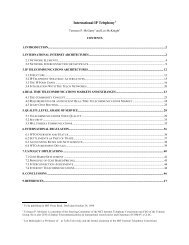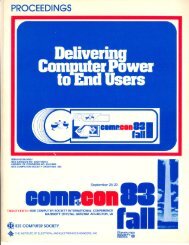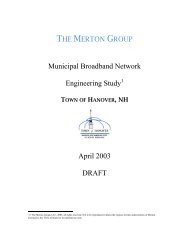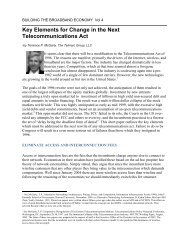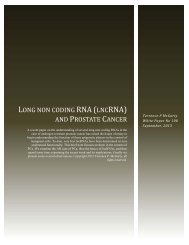progressivism, individualism, and the public ... - Telmarc Group
progressivism, individualism, and the public ... - Telmarc Group
progressivism, individualism, and the public ... - Telmarc Group
You also want an ePaper? Increase the reach of your titles
YUMPU automatically turns print PDFs into web optimized ePapers that Google loves.
The <strong>Telmarc</strong> <strong>Group</strong><br />
PROGRESSIVISM, INDIVIDUALISM, AND THE PUBLIC<br />
INTELLECTUAL<br />
to those who could not afford <strong>the</strong>m <strong>and</strong> <strong>the</strong> elimination of Glass Steagall. Like Hayek,<br />
<strong>the</strong> individualists does not like a libertarian look upon laissez fairs as <strong>the</strong> model of perfect<br />
economic viability, <strong>the</strong>re is a role for Government, to ensure that "property" is protected<br />
<strong>and</strong> those having fiduciary responsibilities <strong>and</strong> accruing <strong>the</strong> gains have a concomitant<br />
liability, personally if necessary.<br />
The authors continue:<br />
"From a legal <strong>and</strong> policy perspective, Coase’s <strong>the</strong>sis had two profound implications.<br />
First, <strong>and</strong> most obviously, Coase demonstrated that in many cases <strong>the</strong> only form of<br />
government intervention required to address an apparent externality was to create<br />
clear property rights <strong>and</strong> workable means of adjudication, <strong>and</strong> <strong>the</strong> market would do <strong>the</strong><br />
rest. More intrusive forms of government intervention—whe<strong>the</strong>r in <strong>the</strong> form of tax<br />
incentives, regulations, or even (as in <strong>the</strong> case of <strong>the</strong> electromagnetic spectrum)<br />
expropriation—were simply not necessary.<br />
Coase also recognized, however, that <strong>the</strong>re are times when <strong>the</strong> costs of negotiating<br />
among multiple parties would make market solutions infeasible.<br />
When <strong>the</strong> transfer of rights has to come about as a result of market transactions carried<br />
out between large numbers of people or organizations acting jointly, <strong>the</strong> process of<br />
negotiation may be so difficult <strong>and</strong> time-consuming as to make such transfers a practical<br />
impossibility … In <strong>the</strong>se circumstances it may be preferable to impose special<br />
regulations (whe<strong>the</strong>r embodied in a statute or brought about as a result of <strong>the</strong> rulings of<br />
an administrative agency).<br />
Thus Coase recognized that <strong>the</strong> least cost way was having clear property rights <strong>and</strong> costs<br />
<strong>and</strong> <strong>the</strong>n seek remediation between <strong>the</strong> parties. However, <strong>and</strong> this is critical, Coase was<br />
not laissez fair, namely leave all decisions to <strong>the</strong> free market, for <strong>the</strong>re were time when<br />
tee costs of doing so exceeded <strong>the</strong> benefit if left amongst <strong>the</strong> parties <strong>and</strong> thus <strong>the</strong> least<br />
cost way was to have <strong>the</strong> Government take that function. Thus <strong>the</strong> Coasian world was not<br />
a world with any Government but a world with a rational Government where <strong>the</strong><br />
Government did what was cost effective.<br />
Finally <strong>the</strong> author's state:<br />
"Until Coase, externalities were seen as bad acts, <strong>the</strong> willful imposition of harm by a<br />
wrongdoer on an innocent victim. Given this characterization, <strong>the</strong> appropriate policy<br />
objective was to stop <strong>the</strong> wrongdoer <strong>and</strong> make <strong>the</strong> victim whole. But Coase explained that<br />
<strong>the</strong> relationship between <strong>the</strong> party “imposing” <strong>the</strong> externality <strong>and</strong> <strong>the</strong> one “affected by”<br />
it was in fact reciprocal. For example, a rule prohibiting a locomotive from emitting<br />
sparks into <strong>the</strong> farmer’s fields imposed costs on <strong>the</strong> railroad that are no different, in kind,<br />
from <strong>the</strong> costs that would be borne by <strong>the</strong> farmer under a rule requiring crops to be<br />
planted fur<strong>the</strong>r back from <strong>the</strong> tracks. The Coasian objective, <strong>the</strong>n, is to determine which<br />
rule imposes <strong>the</strong> least costs on society overall—whe<strong>the</strong>r it is more efficient, that is, to<br />
Page 111



